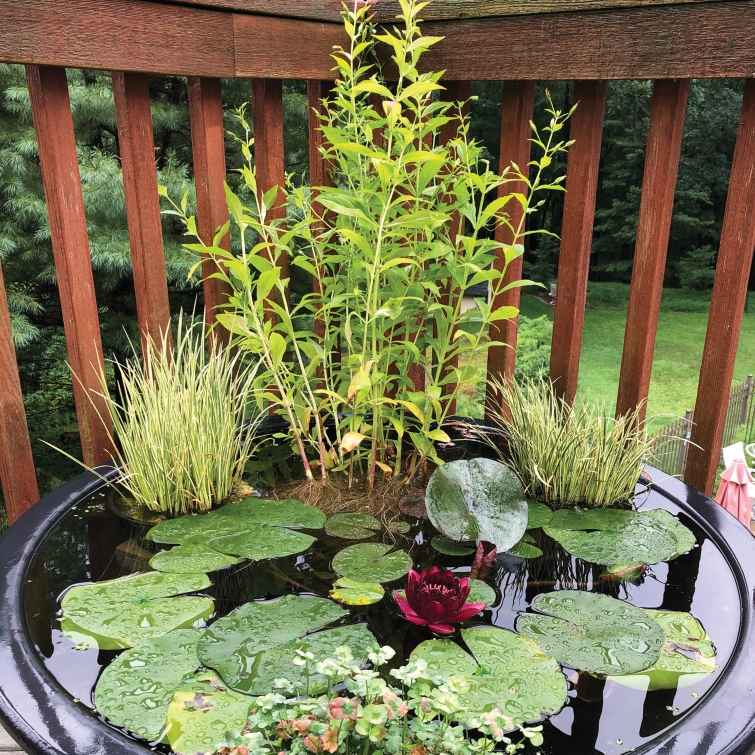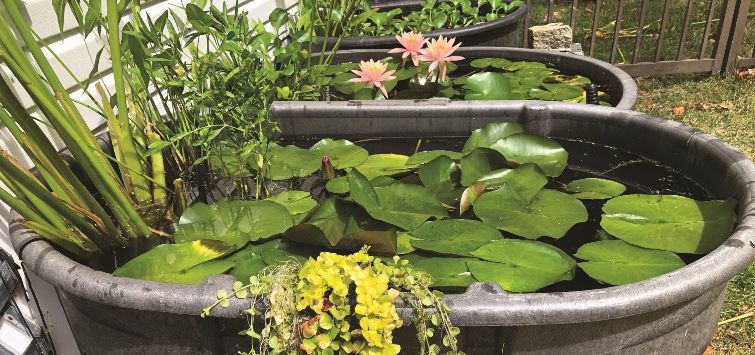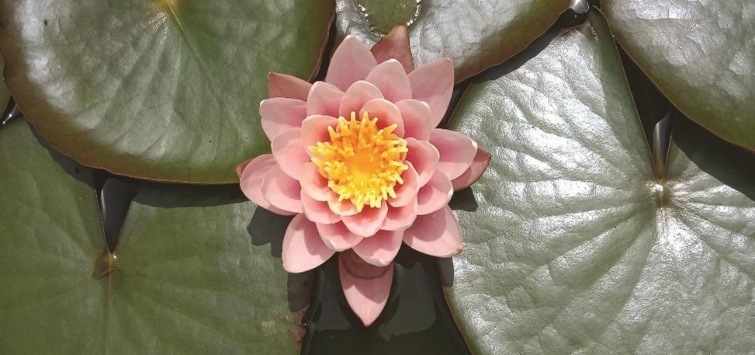Booking a Summer Tub Pond Vacation for Your Fish
Rebecca Goldring
Every year, as the weather begins to warm and days get longer, I start to itch for summer tubbing season. Summer tub ponds aren’t just for water lilies and goldfish—they can make wonderful seasonal homes for a wide variety of freshwater tropical fish, and even year-round homes for some temperate ones.
While a lot of folks keep small lily tubs or whiskey barrel water gardens, summer tubs come in many shapes and sizes, and are suitable for more than just guppies. Whether you’d like to grow out your angelfish spawn or try your hand at spawning a small cyprinid, there’s a tub out there for you.
In the last issue, Dr. Ted Coletti discussed setting up and maintaining tub ponds. In this follow-up to the good doctor’s advice for setting up, planting, and maintaining various container water gardens, let’s take a look at giving your aquarium fish a summer vacation—and kicking your fishkeeping up a notch—with some summer tubbing.
A Summer Getaway
Summer tubs range from simple barrel gardens with plants and no filtration to large stock tanks with pressurized filters. Your goals for your summer tub, the fish you plan to stock in it, seasonal weather patterns, and how much space you have will all factor into the tub or tubs you choose and where you put them.Whether you’re selecting fish for your tub or a tub for your fish, consider their oxygenation and temperature needs. Oxygenation depends on the surface area and depth of your tub, the temperature of the water, and movement at the water’s surface. While I prefer to use a pump and some form of filtration to aid in gas exchange, plenty of folks are successful without that, particularly with shallow, partially shaded tubs with large water surfaces.
There are a variety of reasons for adding fish to summer tubs. Some people do it for mosquito control, and others use the tubs (and their associated mosquito larvae) to grow, condition, and spawn fish. Outdoor tubs house an abundance of microorganisms and small invertebrates. Even if you set a container of clean, clear water outside without plants or livestock, you’ll find an abundance of microscopic life starting to colonize it within days. Give it a couple more, and you’ll have insect larvae, leaf litter, and other beginnings of a veritable underwater buffet. In outdoor aquatic tub gardens, even the smallest fry will find something to eat and a place to hide.
And it can have a direct impact on breeding, fry development, and fish health. The relative abundance of attractive (and live) food options even helps to keep larger fish sated and less interested in snacking on their own offspring. The nutrient-dense live foods found in outdoor tub gardens can help condition adult fish, encourage spawns, and feed grow-outs. While I still supplement with prepared or frozen foods a few times a week, my fish never look better than when they’re outside feasting in the tubs.
Whiskey Barrels and Other Small Tubs

Small tubs are best placed in areas where they’ll get full to partial shade throughout the day, because full sun can (and will) heat small volumes of water to deadly temperatures in a relatively short period of time. Smaller volumes of water also respond to ambient temperature fluctuations more quickly than larger ones and are subject to large (and fast) temperature swings.
One of my favorite summer tub options is the round 35-gallon (about 130-liter) type with three “plant ledges” commonly available at home improvement stores, which is also favored by Dr. Coletti. The ledges provide easy places to put marginal plants, and the center is large enough to fit a small fountain pump in a filter box or a potted lily. Its size allows it to fit on a deck or balcony, but it also won’t be easily overcrowded by spawning fish. Compared to its depth, it has a relatively large surface diameter, allowing for plentiful gas exchange at the surface.
The “go-to” small tub pond fish tend to be small livebearers, like Endler’s or guppies, but many other nano fish make suitable and, in my opinion, more interesting residents. If you don’t plan to use any sort of pump or mechanical filtration, you can still add fish, but I recommend choosing those native to still waters rather than high-flow areas. Smaller labyrinth fish, such as sparkling gouramis or paradise fish, make ideal residents for still-water summer tubs.
If you plan to provide some flow or have a shallow tub with a comparably large surface area, a variety of small cyprinids, characins, and similar fish would do well and can survive temperatures from late spring through early fall. Tubs with dense plant growth provide egg-scattering and mop-spawning fish with attractive nursery sites and give the resulting young plenty of cover to avoid being eaten by their parents.
My personal favorites include glow-light danios, white cloud mountain minnows, and lampeye killifish. All three of these will breed readily in a tub, so it’s important not to overstock when you add your adults. While often sold as “tropical” fish, these three tolerate a wide range of temperatures and come from temperate climates. This allows for an extended tub season and ensures that you won’t have to worry if you have a bout of unusually cool summer weather.
Of course, you’re not limited to small schooling fish. One of my go-to fish for smaller summer tubs is a diminutive U.S. native, the Okefenokee pygmy sunfish (Elassoma okefenokee), which comes to us from Florida’s (you guessed it) Okefenokee swamp. The largest specimens barely reach 1 inch (2.5 cm), and they are considered full-grown adults at ¾ inch (2 cm).
While females are drab, males have velvety black bodies bejeweled with shining aquamarine patches of scales. Males put on quite an elaborate spawning display, performing an intricate dance with their fins. Though you’re not likely to witness this in a summer tub, you’ll know your Okefenokees have been doing the sunfish shimmy when fry begin to show up.
While E. okefenokee only accept live foods, they don’t tend to cannibalize each other. They also have a much longer tub season than other fish, owing to their North American swamp of origin. Although Florida doesn’t freeze often, these little fish are built to tolerate brief periods of relatively extreme cold and can be placed outside early and brought back in late. By summer’s end, I often find fry ranging in size from mere millimeters to full-grown adults.
Stock Tanks & Larger Tubs
Most farm and feed stores, as well as some home and garden centers, have a wide variety of structural foam stock tanks available for sale. These range in size from a modest 50 gallons all the way up to 350 gallons (190 to 1,300 liters), with many options in between.While pricier, the volume of these tubs means space for more (or larger) fish and plants. One downside of the larger stock tanks, however, is that the surface area isn’t sufficiently large in relation to the depth. In deeper tanks, it’s necessary to use some sort of pump or filter large enough to ensure adequate oxygenation of the full water column.
Most of these stock tubs are also intended to be kept outdoors year-round, full of water, and serving as a water source for horses or cows, so they can stand up to almost anything an aquarist can throw at them. They can be drained and stored upside-down, though they can even be left full without a problem—just be sure to drain any plumbing. They can even be dug into the ground, partially or fully, and made into a real “mini pond.”
I have a few of the stock tanks and find them most useful as either grow-outs for large cichlid spawns or a conditioning habitat for predatory fish. As Dr. Coletti mentioned in last month’s article, summer tub maintenance and feeding are fairly minimal. Plants help to keep waste materials under control and serve as a habitat for an assortment of microorganisms and insect larvae, providing a constant food source perfect for meeting the metabolic needs of quickly growing fry.
The larger space also means skipping the frequent, sometimes daily, water changes usually needed to keep fry growing at a healthy pace. Provided you get enough rain throughout the summer, water changes and top-offs might even take care of themselves.
My two large stock tanks are too deep to leave still and are placed in sunny areas. This means that I have to use a pond pump to keep water moving sufficiently to keep it oxygenated. One serious downside of this is that newly hatched fry are easily sucked into the pump and filter. It’s rare that I have tub pond fish actually successfully breed in them, and they work much better as grow-outs than as breeding habitats.
I also occasionally use them to condition fish for breeding. The abundance of live nutritious food available in tubs puts adult fish of all varieties “in the mood.” My only spawns of leopard frog plecos (Peckoltia compta) and Orinoco dwarf pike cichlids have come after a few months out in a tub feasting on invertebrates, snails, and tadpoles. I’ve also used the tub to grow and fatten up spotted Congo puffers (Tetraodon schoutedeni). It made for an easy way to ensure that somewhat picky molluscivorous fish had an adequate food supply while I took a summer vacation.
Some Lessons Learned
While my experiences with summer tubbing have been mostly positive, I’ve learned a few important lessons along the way. I’ve had experiences with tub pond fish that jumped right out within minutes of being placed, dogs who found a tub too attractive to turn down on a hot day (picture a Great Pyrenees in a patio pond), drowned birds, overflows, and cold snaps.Overall, I recommend using a small drill bit to add some drain holes near the top edge. This will prevent massive overflows during downpours and prevent smaller fish from jumping over the edge. On the foam tubs, if you don’t mind fitting a bulkhead, you can easily add a PVC standpipe. I like to leave my standpipe unglued so that I can adjust the water level by changing the angle of it.
If you have particularly valuable fish (or large ones), you can use netting to cover your tub and keep them in and some predators or other undesirables out—probably not the dog, though. To do this, while keeping the netting taut and high above any plants, I drill small holes around the edge of a tub and fit them with fender clips. You can then stretch a pond net and loop it taut around the fender clips. Just don’t pull it so tight that it tears. Depending on the water level, this will also keep pond netting clear of taller plants and floating planters.
I’m frequently asked what I do with my tub pond if the weather gets unseasonably cold in the summer. Typically, I keep an eye on weather and have a few heaters available for longer cold spells. If just the air temperatures drop, water temperatures usually stay within a safe range for most tropical fish, but if cool nights accompany overcast, dreary, cooler-than-usual days, particularly with a lot of cool rain falling, temperatures can sink pretty low, especially in smaller tubs. Having a heater handy might not warm up the whole tub, but it will give fish a warmer area to congregate in and might save some lives if thermometers head south.
One other thing I like to do is establish a pattern for feeding so that I can do basic health checks on my tub pond fish. This can be something simple, like always putting a hand in the water and wiggling fingers before dropping in something particularly tasty. While many fish don’t need supplemental feeding while outdoors, establishing this kind of pattern encourages fish to come on over when they see the “food incoming!” signal. Ideally, this puts them where it’s easier to see them and gauge their physical condition, look for signs of illness or injury, and make sure individuals are accounted for.
Happy Tubbing!

.png?h=595&iar=0&w=2781&hash=5FD5E69473BCC22199FBFA2FB71B6033)









